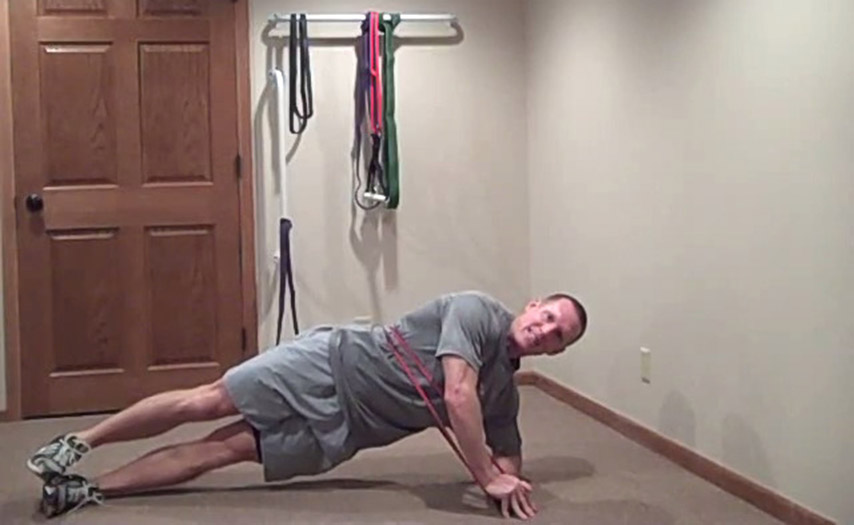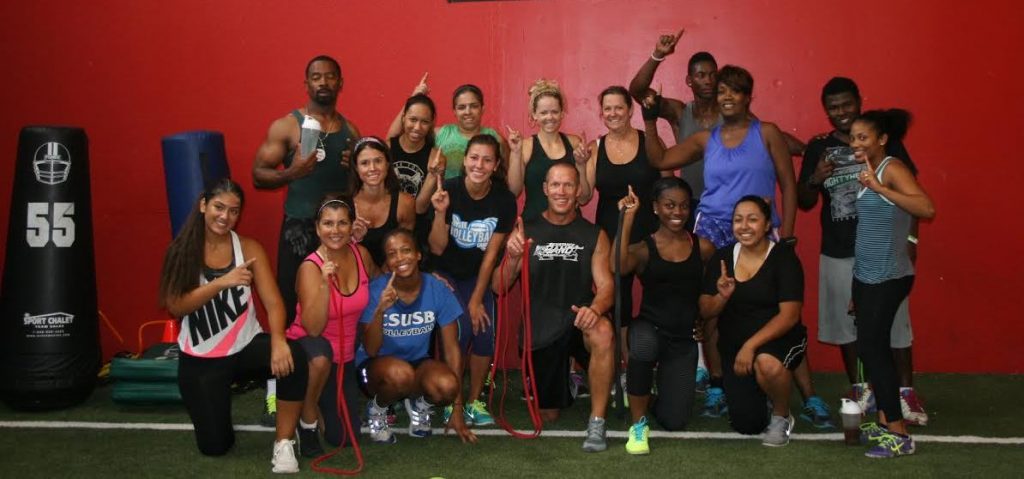Muscle soreness is a bi-product of overloading the eccentric or lengthening phase of a strength training movement, especially as it relates to the final 30% of the movement.
Examples would be the lowering down of the weight during a squat, bench press or shoulder press. It is during this phase of the exercise where the muscles are being forced to contract, lengthen and slow down (or control) momentum simultaneously. Having to do all 3 of these at one time puts a lot of strain on the muscle fibers and tendons as well as surrounding joints.
Even though this is expected, it’s what creates a tremendous amount of muscle and joint exercise induced trauma. This leads to why you are stiff and sore the day or 2 after a workout.
During the eccentric phase of movement, muscle and joint trauma occurs which leads to soreness.
Training with bands (vs. weights) and specifically training with an Ascending Resistance (vs. a free weight constant resistance), does not create as much tension during this eccentric phase. This, in turn, decreases the amount of muscle/joint trauma and subsequent soreness you experience the next day. However, bands still create a resistance that allows you to work hard, build muscle and get stronger.
Let me share some examples of where this eccentric phase is created with traditional strength training exercises:
- When the barbell is moving towards your chest on a bench press
- As you lower the body into a squat or a lunge while holding kettlebells
- At the bottom of a barbell dead-lift
- At the bottom of a barbell or a dumbbell curl
- When the hands are behind the head on a skull crusher or an overhead triceps press
- Right before you go to push a weight overhead
If you look at performing these same movements with a resistance band, which has an ascending resistance vs. a constant resistance, the load is less on the muscle at those points. This means there is significantly less tension on the muscle at the end of the eccentric phase of the movement.
As a result of less tension, muscles are not being loaded as much. Therefore, there will be less soft tissue strain. This leads to less muscle soreness with band training.
Resistance Band Training and Weight Training Questions
1. Is muscle soreness an indicator of a good workout?
Even though many fitness enthusiasts consider muscle and joint soreness a bi-product of a great workout, as a trainer and physical therapist, I know it means I created inflammation. If continually repeated without proper recovery or monitoring, it will ultimately lead to an overuse injury and potentially having to stop working out all together.
From a joint and soft tissue standpoint, resistance bands will definitely create significantly less exercise induced trauma. This is what causes post exercise soreness, often referred to as DOMS (delayed onset of muscle soreness).
However, lack of muscle soreness with band training does not mean you are not working. It simply means the soft tissues were not aggressively stretched and strained to the point where inflammation was created.
2. Can you get muscle soreness with band training?
Absolutely you can create DOMS. However, you must create increased tension at the end of the eccentric phase of the exercise. To do this, you must keep tension on the system and increase the starting tension on the band. This often does not occur for 3 reasons.
First, individuals are using too strong of a band and in order for them to train through a full range of motion, they have to start out with minimal to no tension on the band at the start of the exercise which is also the end of the eccentric phase.
By using the correct size band and keeping a strong tension on the system at all times, an aggressive eccentric lengthening can be created on the muscles at the end of the eccentric phase and at the start of the concentric phase.
Second, many individuals do not train through a full range of motion but instead do partial range of motion reps. You see this with free weight training as well as with band training.
Short range reps don’t challenge the eccentric range of motion so muscle soreness is less likely.
Third, most clients do not set up the band to be loaded through a full range of motion. Granted, the band is a fixed length whereas each individual’s body comes in a variety of lengths.
However, in most cases a band can be quickly shortened to adapt to different arm or leg lengths. This will, in turn, create a challenging tension throughout the full range of motion. Especially when performing band attached training, all an individual needs to do is move further away from the attachment point to create a higher pre-loaded tension.
All of these situations can be quickly resolved so clients can be challenged with an aggressive load throughout the full range of motion. However, it will require more than simply picking up a bigger dumbbell or slapping more weight on the bar. It will require placing the correct size band at the correct length at the starting point of the exercise.
3. What else makes band training more joint and soft tissue friendly?
There are a few other reasons why band training is more well-liked by your joints and soft-tissues:
- They are not gravity dependent so it allows clients to challenge muscles with multiple resistance vectors. This in turn, does not cause muscles or joints to be repeatedly stressed along the same pattern of motion. As a result, the likelihood of overuse trauma decreases. An example of this is using a standing chest press vs. always bench pressing.
- The resistance on a band is extremely variable. This allows clients to quickly increase or decrease resistance as fatigue increases. This also eliminates creating compensation of movement that can lead to joints being awkwardly stressed.
- Most band exercises create a strong activation of the primary stabilizing muscles of the core, hip or scapular region. As a result, improved stabilization decreases joint compression forces that lead to joint pain.
4. Is lifting weights bad for my body long term?
I believe that age appropriate and more importantly, fitness level appropriate, free weight training is great and should be used. Not performed with good technique or within a well designed program, aggressive free weight training as well as band training can ultimately lead to injury issues, especially as the body ages.
However band training is going to provide the user with a lot friendlier learning curve and as noted, a more joint friendly option.
Another thing to keep in mind is that muscles are dumb. They do not know what they are strength training against. They simply adapt to the applied stress brought upon them. Therefore, if the goal is to get stronger, burn calories and generate a high level of work intensity (while not creating unnecessary pain and joint trauma), this can definitely be achieved with resistance band training.
Summary
It has been proven that over time only strength training with free weights will cause joints to wear out faster. It will also cause tendons to become more frequently inflamed. That said, training only with free weights or body weight (which is a free weight as well), will not be conducive to fitness longevity.
As an active aging fitness enthusiast, my first objective of a workout should be to answer yes to “Did I work Hard”? The next goal should be to create a workout environment that allows exercise to become a life-long habit. These requires exercising smart as well as hard.
As we age or the more “out of shape” we become, the more sensitive our joints and muscle tissues become to exercise induced trauma. If the goal is to work hard, increase strength and be able to strength train regularly (while avoiding injury), I think resistance band training needs to be a major part of any strength training program.
Stop Beating Up Your Body Only Lifting Weights!!
Get RBT into Your Workouts the Right Way
Consider Joining the Band Gym and Let Dave Coach You for a Full Year
Take A Gym Tour
***************************************




